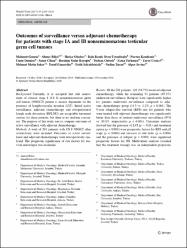| dc.contributor.author | Gümüş, Mahmut | |
| dc.contributor.author | Bilici, Ahmet | |
| dc.contributor.author | Odabaş, Hatice | |
| dc.contributor.author | Öven Ustaalioğlu, Bala Başak | |
| dc.contributor.author | Kandemir, Nurten | |
| dc.contributor.author | Demirci, Umut | |
| dc.contributor.author | Cihan, Şener | |
| dc.contributor.author | Bayoğlu, İbrahim Vedat | |
| dc.contributor.author | Öztürk, Türkan | |
| dc.contributor.author | Türkmen, Esma | |
| dc.contributor.author | Urakçı, Zürat | |
| dc.contributor.author | Şeker, Mehmet Metin | |
| dc.contributor.author | Günaydın, Yusuf | |
| dc.contributor.author | Selçukbiricik, Fatih | |
| dc.contributor.author | Turan, Nedim | |
| dc.contributor.author | Sevinç, Alper | |
| dc.date.accessioned | 10.07.201910:49:13 | |
| dc.date.accessioned | 2019-07-10T20:04:41Z | |
| dc.date.available | 10.07.201910:49:13 | |
| dc.date.available | 2019-07-10T20:04:41Z | |
| dc.date.issued | 2017 | en_US |
| dc.identifier.citation | Gümüş, M., Bilici, A., Odabaş, H., Öven Ustaalioğlu, B. B., Kandemir, N., Demirci, U. ... Sevinç, Ş. (2017). Outcomes of surveillance versus adjuvant chemotherapy for patients with stage IA and IB nonseminomatous testicular germ cell tumors. World Journal of Urology, 35(7), 1103-1110. https://dx.doi.org/10.1007/s00345-016-1964-6 | en_US |
| dc.identifier.issn | 0724-4983 | |
| dc.identifier.issn | 1433-8726 | |
| dc.identifier.uri | https://dx.doi.org/10.1007/s00345-016-1964-6 | |
| dc.identifier.uri | https://hdl.handle.net/20.500.12511/4091 | |
| dc.description | WOS: 000404154000013 | en_US |
| dc.description | PubMed ID: 27812752 | en_US |
| dc.description.abstract | Background Currently, it is accepted that risk assessment of clinical stage I (CS I) nonseminomatous germ cell tumors (NSGCT) patient is mainly dependent on the presence of lymphovascular invasion (LVI). Initial active surveillance, adjuvant chemotherapy and retroperitoneal lymph node dissection (RPLND) are acceptable treatment options for these patients, but there is no uniform consensus. The purpose of this study was to compare outcomes of active surveillance with adjuvant chemotherapy. Methods A total of 201 patients with CS I NSGCT after orchiectomy were included. Outcomes of active surveillance and adjuvant chemotherapy were retrospectively analyzed. The prognostic significance of risk factors for survival and relapse was evaluated. Results Of the 201 patients, 110 (54.7%) received adjuvant chemotherapy, while the remaining 91 patients (45.3%) underwent surveillance. Relapses were significantly higher for patients underwent surveillance compared to adjuvant chemotherapy group (18.3 vs. 1.2%, p < 0.001). The 5-year relapse-free survival (RFS) rate for patients who were treated with adjuvant chemotherapy was significantly better than those of patients underwent surveillance (97.6 vs. 80.8%, respectively; p < 0.001). Univariate analysis showed that the presence of LVI (p = 0.01) and treatment option (p < 0.001) were prognostic factors for RFS and pT stage (p = 0.004) and invasion of rete testis (p = 0.004) and the presence of relapse (p < 0.001) were significant prognostic factors for OS. Multivariate analysis revealed that the treatment strategy was an independent prognostic factor for RFS (p < 0.001, HR 0.54). A logistic regression analysis demonstrated that treatment options (p = 0.031), embryonal carcinoma (EC) > 50% (p = 0.013) and tumor diameter (p = 0.016) were found to be independent factors for predicting relapse. Conclusion Our results indicate that adjuvant chemotherapy is associated with improved RFS compared with surveillance for CS I NSGCT patients. Moreover, the treatment strategy is an important prognostic indicator for RFS and a predictive factor for relapse. Although adjuvant chemotherapy seems to be a suitable treatment for patients with risk factors for relapse, surveillance is still preferred management option. | en_US |
| dc.language.iso | eng | en_US |
| dc.publisher | Springer | en_US |
| dc.rights | info:eu-repo/semantics/embargoedAccess | en_US |
| dc.subject | Stage I | en_US |
| dc.subject | Nonseminomatous Germ Cell Tumor | en_US |
| dc.subject | Testicular Cancer | en_US |
| dc.subject | Chemotherapy | en_US |
| dc.subject | Surveillance | en_US |
| dc.title | Outcomes of surveillance versus adjuvant chemotherapy for patients with stage IA and IB nonseminomatous testicular germ cell tumors | en_US |
| dc.type | article | en_US |
| dc.relation.ispartof | World Journal of Urology | en_US |
| dc.department | İstanbul Medipol Üniversitesi, Tıp Fakültesi, Dahili Tıp Bilimleri Bölümü, İç Hastalıkları Ana Bilim Dalı | en_US |
| dc.identifier.volume | 35 | en_US |
| dc.identifier.issue | 7 | en_US |
| dc.identifier.startpage | 1103 | en_US |
| dc.identifier.endpage | 1110 | en_US |
| dc.relation.publicationcategory | Makale - Uluslararası Hakemli Dergi - Kurum Öğretim Elemanı | en_US |
| dc.identifier.doi | 10.1007/s00345-016-1964-6 | en_US |
| dc.identifier.wosquality | Q1 | en_US |
| dc.identifier.scopusquality | Q1 | en_US |


















